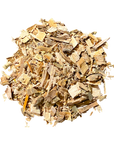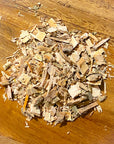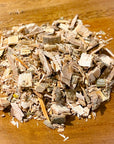


White Willow Bark
Botanical name: Salix alba
^Organic
White willow bark, scientifically known as Salix alba, is derived from the bark of the white willow tree, which belongs to the Salicaceae family. This tree is native to Europe and Asia, commonly found near rivers and wetlands, thriving in moist, well-drained soils. White willow bark is characterized by its grayish-brown color and distinctive long, narrow leaves.
In herbal medicine, white willow bark has been traditionally valued for its potential analgesic and anti-inflammatory properties. The bark contains salicin, a compound that is converted into salicylic acid in the body, similar to the active ingredient in aspirin. White willow bark can be prepared as a tea, tincture, or extract, offering a slightly bitter flavor.*
*These statements have not been evaluated by the Food and Drug Administration. This product is not intended to diagnose, treat, cure, or prevent any disease. For educational purposes only.



